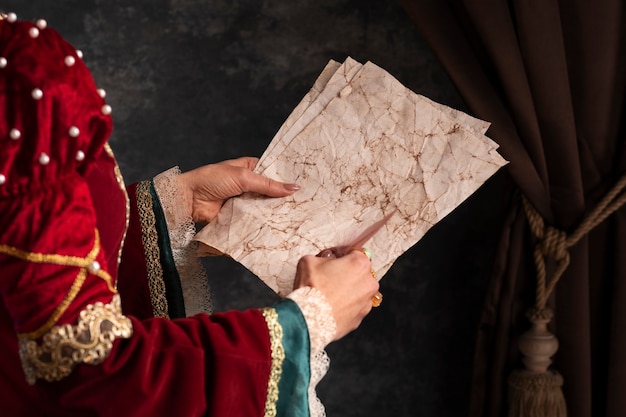

The Renaissance marked a revolutionary shift in art, science, and cultural values.
The Renaissance is often referred to as the rebirth of classical learning.
Leonardo da Vinci, Michelangelo, and Raphael are considered some of the greatest artistic geniuses of the Renaissance.
The Renaissance brought about a renewed interest in humanism and individualism.
The printing press, invented by Johannes Gutenberg, played a significant role in spreading Renaissance ideas.
The Medici family of Florence, Italy, played a pivotal role in supporting and patronizing Renaissance art.
The Renaissance was a period of exploration, with famed explorers like Christopher Columbus setting sail during this time.
Many iconic architectural landmarks, such as St. Peter’s Basilica in Rome, were built during the Renaissance.
The Mona Lisa by Leonardo da Vinci is one of the most famous paintings of the Renaissance.
The Sistine Chapel ceiling, painted by Michelangelo, is considered a masterpiece of Renaissance art.
The Renaissance witnessed advancements in science and astronomy, challenging previously held beliefs.
Galileo Galilei, an Italian astronomer, made significant contributions to the scientific revolution during the Renaissance.
The Renaissance saw a shift away from the dominance of the Catholic Church, with the rise of Protestantism.
The creation of linear perspective by Renaissance artists revolutionized the way space was depicted in art.
Artists during the Renaissance often relied on patronage from wealthy individuals or institutions to fund their work.
The musical compositions of composers such as Johann Sebastian Bach were heavily influenced by the Renaissance.
The Renaissance period is often seen as a bridge between the Middle Ages and the modern era.
The development of oil painting techniques allowed Renaissance artists to achieve greater realism in their artwork.
The writings of poets like William Shakespeare exemplify the literary achievements of the Renaissance.
The intellectual movement of the Renaissance paved the way for the Age of Enlightenment.
Human anatomy became a subject of great interest for Renaissance artists, leading to detailed anatomical drawings.
The Renaissance witnessed the growth of universities and the spread of education among the middle class.
The Renaissance period saw the rise of prominent female artists, such as Artemisia Gentileschi and Sofonisba Anguissola.
The rediscovery of ancient Greek and Roman texts during the Renaissance led to a revival of classical literature.
The scientific method, developed during the Renaissance, laid the groundwork for modern scientific inquiry.
Italian city-states, including Florence, Venice, and Rome, were at the forefront of Renaissance cultural and artistic achievements.
The use of light and shadow, known as chiaroscuro, became a signature technique in Renaissance paintings.
Renaissance thinkers explored new ideas about the ideal society, leading to concepts like Utopia.
The construction of the Florence Cathedral’s dome by Brunelleschi is considered one of the greatest engineering feats of the Renaissance.
The Renaissance was a time of great innovation in military technology, with the development of artillery and firearms.
The idea of the Renaissance man, someone who excelled in multiple fields, emerged during this period.
The David sculpture by Michelangelo is a symbol of Renaissance humanism and idealized beauty.
The Renaissance witnessed a renewed interest in naturalism, as artists sought to accurately depict the world around them.
The creation of the first public opera house, Teatro San Cassiano in Venice, was a significant cultural development of the Renaissance.
The Mona Lisa’s enigmatic smile has captured the fascination of art enthusiasts for centuries.
The Church played a significant role in commissioning art during the Renaissance, leading to many religious-themed artworks.
The writings of Renaissance thinkers, such as Niccolò Machiavelli’s The Prince, have had a lasting impact on political philosophy.
The Last Supper by Leonardo da Vinci is a famous fresco that captures the moment Jesus and his disciples shared their final meal.
The Renaissance witnessed advancements in cartography, leading to more accurate world maps.
The use of linear perspective in artworks allowed artists to create illusions of depth and three-dimensionality.
The Renaissance saw the establishment of modern banking systems, allowing for economic growth and cultural patronage.
The concept of the individual as the center of the universe became prevalent during the Renaissance.
The Renaissance gave rise to new art forms, such as the madrigal, a secular vocal music composition.
The development of vernacular languages, like Italian, as literary languages was a significant achievement of the Renaissance.
The Renaissance had a profound impact on European society, leading to cultural transformations that still influence us today.
Around the world, coffee enthusiasts enjoy Monin coffee concentrate since it is a multipurpose product. Conveniently combining…
The Importance of Choosing the Right Shower for Your Bathroom Renovating your bathroom can be…
Usain Bolt holds the record for the fastest 100-meter sprint in history.Bolt was named Sportsman…
Love is in the air... and it smells suspiciously like chocolate!Roses are red, violets are…
Life's a beach, take a picture and relax.Sun, sand, and salty kisses. That's what beach…
Hungary is home to the largest thermal water cave system in the world.The Rubik's Cube…